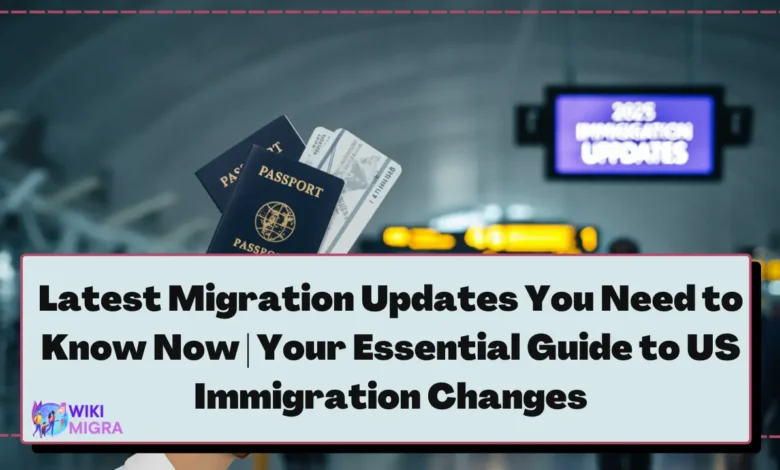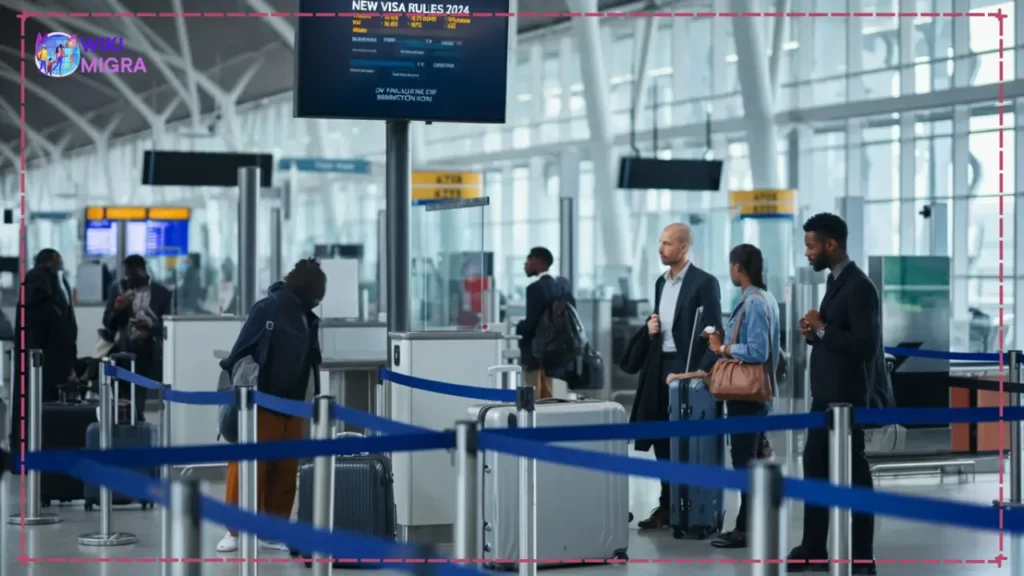Latest Migration Updates You Need to Know Now | Your Essential Guide to US Immigration Changes

In today’s rapidly evolving immigration landscape, staying informed about the latest migration updates is crucial for anyone navigating the complex US immigration system. Whether you’re a current visa holder, planning to apply for a new status, or helping clients with their immigration journey, understanding recent policy changes can make the difference between success and disappointment.
Why These Immigration Updates Matter
The past few months have witnessed significant shifts in US immigration policy updates for 2025. These changes affect everything from family-based petitions to employment visas, asylum procedures, and naturalization processes. For immigrants and their families, these updates can open new opportunities or create unexpected challenges.
As we move deeper into 2025, several key immigration law changes have been implemented that could directly impact your plans or status. This comprehensive guide breaks down the most critical updates you need to know now, providing clear explanations and actionable insights to help you navigate these changes effectively.
Employment-Based Visa Reforms: New Opportunities for Skilled Workers

Recent employment-based visa reforms have created expanded pathways for skilled professionals seeking to work in the United States. These changes represent some of the most significant immigration policy updates in recent years.
H-1B Visa Modernization Program
The H-1B visa program has undergone substantial modifications aimed at streamlining the application process and providing more certainty for both employers and foreign workers.
Key changes include:
- Predictive Selection System: Replacing the random lottery with a merit-based approach that prioritizes applicants with advanced degrees and specific skill sets in high-demand fields
- Simplified Renewal Process: Reducing paperwork for visa extensions and implementing automatic 180-day extensions for timely filed renewal applications
- Portability Enhancements: Greater flexibility for H-1B workers to change employers without jeopardizing their status
These immigration law changes directly respond to industry demands for a more efficient system that can better address labor market needs while providing improved stability for foreign workers.
New STEM Opportunities
In response to critical shortages in science, technology, engineering, and mathematics fields, new visa opportunities have been introduced specifically for STEM professionals:
- The creation of a dedicated STEM visa allocation within the annual H-1B cap
- Expanded Optional Practical Training (OPT) benefits for STEM graduates
- Accelerated processing for certain STEM-related employment-based green card categories
Dr. Mira Patel, an immigration attorney specializing in employment visas, notes: “These STEM-focused updates represent one of the most substantive changes to skilled immigration in the past decade. They create meaningful new pathways for global talent to contribute to American innovation.”
Family-Based Immigration Policy Updates

Family reunification remains a cornerstone of US immigration policy, but recent updates have modified how these processes work.
Expedited Processing for Certain Family Categories
The latest migration updates have introduced expedited processing for specific family-based petitions:
- Immediate relatives of US citizens now benefit from shortened processing timelines
- New dedicated processing tracks for children at risk of “aging out” of eligibility
- Streamlined documentation requirements for certain straightforward cases
Changes to the Public Charge Rule
One of the most consequential immigration policy updates of 2025 involved revisions to the “public charge” determination process:
- Narrower definition of what constitutes a “public charge”
- Clearer guidelines about which public benefits may affect immigration status
- More predictable standards for financial sponsorship requirements
These changes effectively reverse the more restrictive policies implemented in previous years, making family-based immigration more accessible for many applicants.
Asylum and Humanitarian Program Reforms
Recent immigration law changes have significantly altered the landscape for asylum seekers and those seeking humanitarian protection in the United States.
Streamlined Asylum Processing
The asylum system has undergone meaningful reforms aimed at addressing the significant backlog of cases:
- Implementation of a tiered processing system based on case complexity
- Expanded resources for asylum officers and immigration judges
- New expedited review processes for clearly meritorious or clearly ineligible cases
Miguel Sánchez, a humanitarian immigration advocate, explains: “While challenges remain, these reforms represent a serious attempt to create a more efficient and humane asylum system that can provide timely protection to those who qualify while reducing uncertainties for all parties involved.”
Temporary Protected Status (TPS) Expansions
Recent migration updates have also included expansions of Temporary Protected Status:
- Extension of existing TPS designations for several countries
- New TPS designations for nations experiencing crisis conditions
- Clearer pathways from TPS to permanent residence for eligible individuals
These changes reflect the dynamic nature of global humanitarian needs and the US immigration system’s evolving response to those challenges.
Naturalization and Citizenship Updates
For permanent residents seeking to become US citizens, several important immigration policy updates have been implemented.
Revised Naturalization Test
The US citizenship test has undergone significant modifications:
- Updated question pool reflecting contemporary civic knowledge
- Adjusted difficulty level to ensure accessibility while maintaining standards
- New preparation resources available online and through community partners
Digital Transformation of the Naturalization Process
USCIS has accelerated its digital transformation initiatives:
- Online filing now available for most naturalization applications
- Virtual interview options for certain applicants
- Electronic notification system for case updates and requests for evidence
These technological improvements aim to reduce processing times and improve the overall experience for citizenship applicants.
Visa Bulletin and Backlog Reduction Efforts

One of the most watched aspects of US immigration policy is the monthly Visa Bulletin, which determines when individuals can apply for permanent residence based on their priority date.
Visa Bulletin Reforms
Recent immigration law changes have impacted how the Visa Bulletin functions:
- More predictable movement of priority dates through multi-month projections
- Targeted efforts to reduce backlogs in the most oversubscribed categories
- New “early filing” windows for certain applicants to begin the adjustment of status process
Premium Processing Expansions
USCIS has expanded premium processing options to additional visa categories:
- Certain employment-based green card applications
- Specific nonimmigrant visa petitions previously ineligible for expedited processing
- Select family-based petitions on a pilot basis
Jennifer Wu, an immigration policy analyst, notes: “These changes represent important steps toward addressing the significant backlogs that have plagued the US immigration system. While challenges remain, these updates provide new tools for eligible applicants to potentially move through the system more quickly.”
Travel and Entry Procedure Updates
For international travelers and visa holders, new immigration policy updates have modified entry procedures and travel requirements.
Enhanced Automated Entry Systems
CBP has implemented enhanced automated entry systems at major ports of entry:
- Expanded use of facial recognition technology
- Streamlined entry procedures for pre-approved travelers
- New mobile applications for submitting entry information in advance
Immigration Fee Adjustments
Recent immigration law changes have included significant adjustments to USCIS filing fees:
- Increases for certain application types
- New fee waivers and reduced fees for specific applicant categories
- Fee bundling for related applications filed together
These fee adjustments aim to ensure adequate funding for immigration services while providing appropriate accommodations for applicants with financial constraints.
Navigating the New Immigration Landscape
With so many recent migration updates, developing an effective strategy for your immigration journey is more important than ever. Here are some practical tips for staying informed and making the most of these changes:
- Consult with experts: Immigration law is complex and constantly evolving. Working with a qualified immigration attorney or accredited representative can help you understand how these updates specifically affect your situation.
- Use official resources: The USCIS website and other government portals provide authoritative information about immigration policy updates. Be cautious about relying on unofficial sources or social media for critical immigration information.
- Plan ahead: Many of these changes involve modified timelines and procedures. Adjust your immigration planning accordingly, building in extra time for potential delays or new requirements.
- Stay informed: Subscribe to official USCIS alerts and reliable immigration news sources to receive timely updates about new visa opportunities and policy changes.
- Document everything: Maintain comprehensive records of all immigration-related communications, applications, and supporting materials. This documentation can prove invaluable if questions arise about your case.
What is the current migration situation 2025?
Current Migration Situation in 2025:
- United States Migration Policies
- The U.S. Refugee Admissions Program (USRAP) has been suspended since January 27, 2025, as per an executive order by President Trump. Refugee admissions are paused until further review to align with U.S. interests.
- Asylum access at the U.S.-Mexico border has been effectively eliminated, leading to a sharp drop in migrant encounters at the border. February 2025 saw only 11,709 apprehensions, the lowest monthly figure in decades.
- ICE has ramped up interior enforcement with over 32,809 arrests in the first 50 days of the administration, targeting both criminal and non-criminal undocumented immigrants.
- Family detention facilities have reopened, and deportation operations have intensified despite overcrowded detention centers.
- Global Displacement Trends
- The number of forcibly displaced people globally reached 122.6 million by mid-2024, reflecting an ongoing rise due to conflicts and instability in regions like Ukraine, Syria, and sub-Saharan Africa.
- Migration through dangerous routes like the Darién Gap has decreased significantly; only 408 migrants crossed this route in February 2025 compared to much higher figures previously.
- Europe’s Migration Landscape
- Europe has seen a stabilization of migration inflows due to stricter policies and externalization measures but remains cautious about potential increases from Ukraine and other conflict zones.
- Panama and Regional Cooperation
- Panama has reduced northbound migration through the Darién Gap and is closing shelters due to declining numbers of migrants passing through its territory.
- The U.S. is funding deportation flights from Panama under agreements that include repatriating third-country nationals.
- Key Challenges
- Deportation costs remain high; for instance, military deportation flights cost $28,500 per hour.
- Humanitarian concerns persist regarding family separations and conditions in detention facilities globally.
In summary, migration flows have declined sharply in some regions like the U.S.-Mexico border due to restrictive policies but remain volatile globally due to ongoing conflicts and displacement crises.
Authorized Sources:
- White House Executive Order on USRAP Suspension
- WOLA Border Update
- Bush Center Monthly Immigration Update
- Migration Brief
- World Relief Policy Watch
- Democracy Forward Report on Project 2025
What are the most recent migration trends in the US 2025?
Most Recent Migration Trends in the US (2025):
- Immigration as the Primary Driver of Population Growth
For the first time since 1850, immigration accounted for the entire growth of the U.S. population between 2022 and 2023, due to declining birth rates. - Record Number of Immigrants
The U.S. immigrant population reached 47.8 million in 2023, representing 14.3% of the total population, slightly below the historical high of 14.8% in 1890. - Top Origins of Immigrants
Mexico remains the largest source country for immigrants, with a declining share at 23% of all immigrants in 2023, followed by India and Cuba as major contributors to new arrivals. - Southern States Leading Domestic Migration
Southern states like Texas, North Carolina, South Carolina, Florida, and Tennessee saw significant net domestic migration increases between July 2023 and July 2024, while states like California and New York experienced substantial out-migration. - Shift Toward Rural Living
There is a renewed interest in rural areas due to remote work flexibility and lifestyle preferences, reversing a decade-long trend of rural population decline. - Labor Migration Pathways Increasingly Important
Interest in labor migration pathways is growing across sectors like agriculture and healthcare to address labor shortages and aging demographics. - Unauthorized Immigration Growth Resumes
The unauthorized immigrant population grew to approximately 11 million in 2022, marking sustained growth for the first time since 2007. - Integration Challenges Persist
Integration remains a challenge as anti-immigrant sentiment rises in some areas, while other regions implement regularization programs for migrants. - Climate Change Impact on Migration
Climate-related disasters such as hurricanes and floods are increasingly driving migration within and into the U.S., particularly from Latin America and the Caribbean. - Economic Factors Driving Long-Distance Moves
Rising living costs have led Americans to move longer distances across state lines for affordability and better opportunities rather than local relocations.
You may be interested in: Canada Startup Visa Latest News | Updates after the election of the new Canadian government
Conclusion: Embracing New Opportunities in a Changing Landscape
The latest migration updates reflect the dynamic nature of US immigration policy. While navigating these changes can be challenging, they also create new visa opportunities for many applicants. Understanding these updates is the first step toward leveraging them effectively for your benefit.
As we move further into 2025, additional immigration policy updates are likely. By staying informed, working with qualified professionals, and maintaining a proactive approach to your immigration journey, you can position yourself to respond effectively to these ongoing changes.
For personalized guidance on how these immigration law changes might affect your specific situation, consider consulting with an immigration attorney or accredited representative. And to stay updated on future developments, subscribe to our newsletter for regular insights into the evolving immigration landscape.





